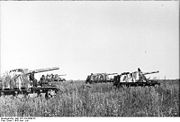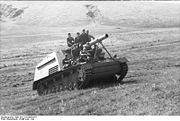.gif)
Hummel (artillery)
Encyclopedia
The Hummel was a self-propelled artillery
gun based on the Geschützwagen III/IV chassis, armed with a 15 cm howitzer
. It was used by the German
Wehrmacht
during the Second World War
from late 1942 until the end of the war.
The full designation was Panzerfeldhaubitze 18M auf Geschützwagen III/IV (Sf) Hummel, Sd.Kfz. 165. On February 27, 1944, Hitler ordered the name Hummel (German: "Bumblebee
") to be dropped as being inappropriate for a fighting vehicle.
 The Hummel was designed in 1942 out of a need for mobile artillery support for the tank forces, the lack of which had first been felt during Operation Barbarossa
The Hummel was designed in 1942 out of a need for mobile artillery support for the tank forces, the lack of which had first been felt during Operation Barbarossa
. There were some self-propelled artillery vehicles already in service with the Wehrmacht
at the time, but most were of limited value.
The first option looked at was to mount a 10.5 cm leFH17 howitzer
on a Panzer III
chassis, but this was rejected in favour of the same howitzer on a Panzer IV
chassis. One prototype was built of this design.
This design was again rejected, this time in favour of a more powerful solution: mounting the 15 cm sFH 18 L/30
howitzer on the specially designed Geschützwagen III/IV, which took elements of both the Panzer III (driving and steering system) and Panzer IV chassis (suspension and engine). The same chassis was also used for the Nashorn
tank destroyer
.
The Hummel had an open-topped lightly armoured fighting compartment at the back of the vehicle which housed both the howitzer and the crew. The engine was moved to the centre of the vehicle to make room for this compartment. Late model Hummels had a slightly redesigned driver compartment and front superstructure, to offer more room to the radio operator and driver.
By the end of the war 714 Hummels had been built with another 150 ammunition carriers using the same design.
 The Hummel first participated in large scale combat at the Battle of Kursk
The Hummel first participated in large scale combat at the Battle of Kursk
, when some 100 Hummels were in service. They served in armored artillery battalions or Panzerartillerie Abteilungen of the Panzer divisions, forming separate heavy self-propelled artillery batteries, each with 6 Hummels and one ammunition carrier.
Deutsches Panzermuseum
, the Wehrtechnische Studiensammlung in Koblenz
and the Sinsheim Auto & Technik Museum
in Germany, the Musée des Blindés
in Saumur
, France, and the Patton Museum of Cavalry and Armor
in Fort Knox, Kentucky.
Self-propelled artillery
Self-propelled artillery vehicles are combat vehicles armed with artillery. Within the term are covered self-propelled guns and rocket artillery...
gun based on the Geschützwagen III/IV chassis, armed with a 15 cm howitzer
Howitzer
A howitzer is a type of artillery piece characterized by a relatively short barrel and the use of comparatively small propellant charges to propel projectiles at relatively high trajectories, with a steep angle of descent...
. It was used by the German
Nazi Germany
Nazi Germany , also known as the Third Reich , but officially called German Reich from 1933 to 1943 and Greater German Reich from 26 June 1943 onward, is the name commonly used to refer to the state of Germany from 1933 to 1945, when it was a totalitarian dictatorship ruled by...
Wehrmacht
Wehrmacht
The Wehrmacht – from , to defend and , the might/power) were the unified armed forces of Nazi Germany from 1935 to 1945. It consisted of the Heer , the Kriegsmarine and the Luftwaffe .-Origin and use of the term:...
during the Second World War
World War II
World War II, or the Second World War , was a global conflict lasting from 1939 to 1945, involving most of the world's nations—including all of the great powers—eventually forming two opposing military alliances: the Allies and the Axis...
from late 1942 until the end of the war.
The full designation was Panzerfeldhaubitze 18M auf Geschützwagen III/IV (Sf) Hummel, Sd.Kfz. 165. On February 27, 1944, Hitler ordered the name Hummel (German: "Bumblebee
Bumblebee
A bumble bee is any member of the bee genus Bombus, in the family Apidae. There are over 250 known species, existing primarily in the Northern Hemisphere although they are common in New Zealand and in the Australian state of Tasmania.Bumble bees are social insects that are characterised by black...
") to be dropped as being inappropriate for a fighting vehicle.
Development

Operation Barbarossa
Operation Barbarossa was the code name for Germany's invasion of the Soviet Union during World War II that began on 22 June 1941. Over 4.5 million troops of the Axis powers invaded the USSR along a front., the largest invasion in the history of warfare...
. There were some self-propelled artillery vehicles already in service with the Wehrmacht
Wehrmacht
The Wehrmacht – from , to defend and , the might/power) were the unified armed forces of Nazi Germany from 1935 to 1945. It consisted of the Heer , the Kriegsmarine and the Luftwaffe .-Origin and use of the term:...
at the time, but most were of limited value.
The first option looked at was to mount a 10.5 cm leFH17 howitzer
Howitzer
A howitzer is a type of artillery piece characterized by a relatively short barrel and the use of comparatively small propellant charges to propel projectiles at relatively high trajectories, with a steep angle of descent...
on a Panzer III
Panzer III
Panzer III was the common name of a medium tank that was developed in the 1930s by Germany and was used extensively in World War II. The official German designation was Panzerkampfwagen III translating as "armoured battle vehicle". It was intended to fight other armoured fighting vehicles and...
chassis, but this was rejected in favour of the same howitzer on a Panzer IV
Panzer IV
The Panzerkampfwagen IV , commonly known as the Panzer IV, was a medium tank developed in Nazi Germany in the late 1930s and used extensively during the Second World War. Its ordnance inventory designation was Sd.Kfz...
chassis. One prototype was built of this design.
This design was again rejected, this time in favour of a more powerful solution: mounting the 15 cm sFH 18 L/30
15 cm sFH 18
The 15 cm schwere Feldhaubitze 18 or sFH 18 , nicknamed Immergrün , was the basic German division-level heavy howitzer during the Second World War, serving alongside the smaller but more numerous 10.5 cm leFH 18...
howitzer on the specially designed Geschützwagen III/IV, which took elements of both the Panzer III (driving and steering system) and Panzer IV chassis (suspension and engine). The same chassis was also used for the Nashorn
Nashorn
Nashorn , initially known as Hornisse , was a German tank destroyer of World War II. It was developed as an interim solution in 1942 and was armed with the outstanding Pak 43 anti-tank gun...
tank destroyer
Tank destroyer
A tank destroyer is a type of armored fighting vehicle armed with a gun or missile launcher, and is designed specifically to engage enemy armored vehicles...
.
The Hummel had an open-topped lightly armoured fighting compartment at the back of the vehicle which housed both the howitzer and the crew. The engine was moved to the centre of the vehicle to make room for this compartment. Late model Hummels had a slightly redesigned driver compartment and front superstructure, to offer more room to the radio operator and driver.
Variants
Because the basic Hummel could only carry a limited amount of ammunition, the Munitionsträger Hummel (ammunition carrier Hummel) was developed. This was basically a standard production Hummel without the howitzer (a 10 mm armour plate covering the gun mount) and with racks fitted to hold the ammunition. When necessary, these could still be fitted with the 15 cm howitzer of the normal Hummel; this could even be done as a field conversion.By the end of the war 714 Hummels had been built with another 150 ammunition carriers using the same design.
Combat history

Battle of Kursk
The Battle of Kursk took place when German and Soviet forces confronted each other on the Eastern Front during World War II in the vicinity of the city of Kursk, in the Soviet Union in July and August 1943. It remains both the largest series of armored clashes, including the Battle of Prokhorovka,...
, when some 100 Hummels were in service. They served in armored artillery battalions or Panzerartillerie Abteilungen of the Panzer divisions, forming separate heavy self-propelled artillery batteries, each with 6 Hummels and one ammunition carrier.
Foreign use
Romania received one unit from the Red Army after the war ended. The Hummel was used by the 2nd Armoured Regiment with the registration number U069009. Officially known as the Hummel TAs self-propelled gun in the army inventory. The gun couldn't be used because it was missing the lock. It was shown to the public on the 10th of May Bucharest parade in 1946 with Romanian markings. All German armour units in Romania were scrapped by 1954.Surviving vehicles
Five Hummels survived the war. They may be seen at the MunsterMunster, Lower Saxony
Munster, also called Munster , is a small town in the district of Heidekreis, in Lower Saxony, Germany almost equidistant from Hamburg and Hanover. The town is home to the German Army's largest garrison and is situated between the two training areas of Munster North and Munster South. It is also...
Deutsches Panzermuseum
Deutsches Panzermuseum
The German Tank Museum is an armoured fighting vehicle museum in Munster, Germany, the location of the Munster Training Area camp. Its main aim is the documentation of the history of German armoured troops since 1917....
, the Wehrtechnische Studiensammlung in Koblenz
Koblenz
Koblenz is a German city situated on both banks of the Rhine at its confluence with the Moselle, where the Deutsches Eck and its monument are situated.As Koblenz was one of the military posts established by Drusus about 8 BC, the...
and the Sinsheim Auto & Technik Museum
Sinsheim Auto & Technik Museum
The Auto & Technik Museum Sinsheim is a technology museum in Sinsheim, Germany. Opened in 1981, it is run by a registered association called "Auto & Technik Museum Sinsheim e.V." which also runs the Technik Museum Speyer. , it has more than 3,000 exhibits and an exhibition area of more than 50,000 m²...
in Germany, the Musée des Blindés
Musée des Blindés
The Musée des Blindés or Musée Général Estienne is a tank museum located in the Loire Valley of France, in the city of Saumur. It is one of the world's largest tank museums....
in Saumur
Saumur
Saumur is a commune in the Maine-et-Loire department in western France.The historic town is located between the Loire and Thouet rivers, and is surrounded by the vineyards of Saumur itself, Chinon, Bourgueil, Coteaux du Layon, etc...
, France, and the Patton Museum of Cavalry and Armor
Patton Museum of Cavalry and Armor
The General George Patton Museum of Leadership is a museum in Fort Knox, Kentucky, dedicated to the memory of General George S. Patton, Jr., and his life from World War I through the present day. The museum is administered by the U.S. Army Accessions Command, Fort Knox...
in Fort Knox, Kentucky.
External links
- Achtung Panzer! profile of the Hummel
- World War II Vehicles
- Surviving Panzer IV variants - A PDF file presenting the Panzer IV variants (Jagdpanzer IV, Hummel, Nashorn, Brummbär, StuG IV, Flakpanzer tanks and prototypes based on Pz IV) still existing in the world

